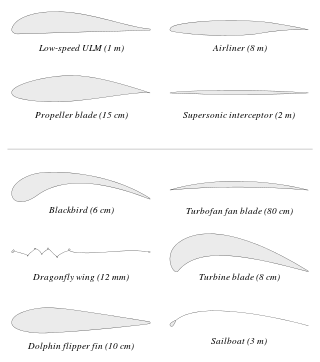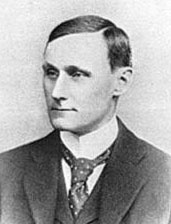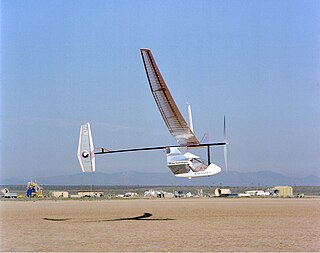Related Research Articles

Aeronautics is the science or art involved with the study, design, and manufacturing of air flight–capable machines, and the techniques of operating aircraft and rockets within the atmosphere. The British Royal Aeronautical Society identifies the aspects of "aeronautical Art, Science and Engineering" and "The profession of Aeronautics ."

A fluid flowing around an object exerts a force on it. Lift is the component of this force that is perpendicular to the oncoming flow direction. It contrasts with the drag force, which is the component of the force parallel to the flow direction. Lift conventionally acts in an upward direction in order to counter the force of gravity, but it can act in any direction at right angles to the flow.

A wing is a type of fin that produces lift while moving through air or some other fluid. Accordingly, wings have streamlined cross-sections that are subject to aerodynamic forces and act as airfoils. A wing's aerodynamic efficiency is expressed as its lift-to-drag ratio. The lift a wing generates at a given speed and angle of attack can be one to two orders of magnitude greater than the total drag on the wing. A high lift-to-drag ratio requires a significantly smaller thrust to propel the wings through the air at sufficient lift.

A fixed-wing aircraft is a heavier-than-air flying machine, such as an airplane, which is capable of flight using wings that generate lift caused by the aircraft's forward airspeed and the shape of the wings. Fixed-wing aircraft are distinct from rotary-wing aircraft, and ornithopters. The wings of a fixed-wing aircraft are not necessarily rigid; kites, hang gliders, variable-sweep wing aircraft and airplanes that use wing morphing are all examples of fixed-wing aircraft.

A waverider is a hypersonic aircraft design that improves its supersonic lift-to-drag ratio by using the shock waves being generated by its own flight as a lifting surface, a phenomenon known as compression lift.

An airfoil or aerofoil is the cross-sectional shape of an object whose motion through a gas is capable of generating significant lift, such as a wing, a sail, or the blades of propeller, rotor, or turbine.

Richard Travis Whitcomb was an American aeronautical engineer who was noted for his contributions to the science of aerodynamics.

An ornithopter is an aircraft that flies by flapping its wings. Designers sought to imitate the flapping-wing flight of birds, bats, and insects. Though machines may differ in form, they are usually built on the same scale as flying animals. Larger, crewed ornithopters have also been built and some have been successful. Crewed ornithopters are generally either powered by engines or by the pilot.

Percy Sinclair Pilcher was a British inventor and pioneer aviator who was his country's foremost experimenter in unpowered flight near the end of the nineteenth century.

Robert T. Jones,, was an aerodynamicist and aeronautical engineer for NACA and later NASA. He was known at NASA as "one of the premier aeronautical engineers of the twentieth century". The papers of Robert T. Jones are in the Stanford University Libraries archives.

The MIT Aeronautics and Astronautics Department's Daedalus is a class of three human-powered aircraft that included Daedalus 88 – which, on 23 April 1988, flew a distance of 115.11 kilometres (71.53 mi) in 3 hours, 54 minutes, from Heraklion on the island of Crete to the island of Santorini. The flight holds official FAI world records for total distance, straight-line distance, and duration for human-powered aircraft.

An airplane, or aeroplane, informally plane, is a fixed-wing aircraft that is propelled forward by thrust from a jet engine, propeller, or rocket engine. Airplanes come in a variety of sizes, shapes, and wing configurations. The broad spectrum of uses for airplanes includes recreation, transportation of goods and people, military, and research. Worldwide, commercial aviation transports more than four billion passengers annually on airliners and transports more than 200 billion tonne-kilometers of cargo annually, which is less than 1% of the world's cargo movement. Most airplanes are flown by a pilot on board the aircraft, but some are designed to be remotely or computer-controlled such as drones.

Harold Roxbee Cox, Baron Kings Norton was a British aeronautical engineer. He was notable for his contributions to British industry, particularly aeronautical engineering, and for his part in the establishment of Cranfield University.
Horatio Frederick Phillips was an English aviation pioneer, born in Streatham, Surrey. He was famous for building multiplane flying machines with many more sets of lifting surfaces than are normal on modern aircraft. However he made a more lasting contribution to aeronautics in his work on aerofoil design.

An aircraft propeller, also called an airscrew, converts rotary motion from an engine or other power source into a swirling slipstream which pushes the propeller forwards or backwards. It comprises a rotating power-driven hub, to which are attached several radial airfoil-section blades such that the whole assembly rotates about a longitudinal axis. The blade pitch may be fixed, manually variable to a few set positions, or of the automatically variable "constant-speed" type.

The Association in Scotland To Research into Astronautics (ASTRA), is a membership-based society that concerns itself with all matters related to space research. Its current center of operations is in the Scottish city of Glasgow and it is affiliated to a number of other bodies, including the Federation of Astronomical Societies and the Glasgow Council for the Voluntary Sector.

In aeronautics, a tailless aircraft is an aircraft with no other horizontal aerodynamic surface besides its main wing. It may still have a fuselage, vertical tail fin, and/or vertical rudder.

A human-powered aircraft (HPA) is an aircraft belonging to the class of vehicles known as human-powered transport.
The Advisory Committee for Aeronautics (ACA) was a UK agency founded on 30 April 1909, to undertake, promote, and institutionalize aeronautical research. In 1919 it was renamed the Aeronautical Research Committee, later becoming the Aeronautical Research Council.
Laurence Joseph Clancy was an Education Officer in aerodynamics at Royal Air Force College Cranwell where his textbook Aerodynamics became standard.
References
- ↑ Flight, 1961 July 20 page 67 (Accessed August 2012)
- ↑ STAAR Research- The Scottish Rocket Programme: An Historical Overview of Waverider Evolution (Accessed August 2012)
- 1 2 The Herald Tuesday 28 December 1999 Obit:Prof Terence Nonweiler (Accessed August 2012)
- ↑ New Scientist 24 Dec 1959 (Accessed August 2012)
- ↑ Reay, D.A (1977). The History of Man-Powered Flight. Pergammon. p. 136. ISBN 978-1483113579.
- ↑ Nonweiler, T. R. F. (1968). "A new series of low-drag aerofoils". Aeronautical Research Council Reports and Memoranda. 3618– via Cranfield University AERADE.
- ↑ Kelling, F. H. (1971). "Experimental investigation of a high-lift low-drag aerofoil". Aeronautical Research Council Current Papers. 1187– via Cranfield University AERADE.
- ↑ "Biography of Terence Nonweiler". University of Glasgow . Retrieved 22 March 2022.